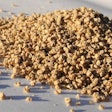U.S. farmers are likely to plant less corn for the 2014 harvest, largely because the input costs will be too high. Chip Flory, editor of Pro Farmer, estimates that corn acreage could decrease by as much as 2 million acres in 2014.
Flory, along with Tom Elam, president of FarmEcon LLC, spoke about the current and upcoming year for feed production during the Grain & Meat Outlook Webinar. The webinar, which was the third in a series and can be viewed online, was hosted by WATTAgNet and Farm Journal, and sponsored by Nutriad.
With a healthy 2013 corn crop mostly harvested, corn prices are lowering. ProFarmer is estimating an average price of $4.75 per bushel for the 2013-2014 marketing year, compared to $6.90 for the previous marketing year. But much of the 2013 harvested crop is going into the bin, keeping the prices from dropping as much as they could.
With an estimated soybean to corn price ratio of 2.44:1, there are financial and other incentives for farmers to shift from corn production to soybean production, Flory said.
"Normally, it takes about 2.5 to move a lot of acres over to soybeans, but there are a lot of corn-on-corn growers that are looking for a break," Flory said, saying there are agronomic reasons such as weeds that will factor into their decisions.
It isn't just soybeans that corn has to compete with, he added. Just a few days before participating in the webinar, Flory said he spoke to some growers who are strongly considering planting less corn and more cotton.
"In the south, there are cotton growers that also grow corn and soybeans. Even if they haven't grown cotton for the last several years, they're still cotton producers. If they've still got the equipment, we're going to see some acres go back to cotton and leave corn, because they're looking at 80 cent futures out there. With 80 cent futures for cotton vs. $4.75 corn, some will be thinking maybe it's time to get that cotton picker out again," said Flory.
The current production costs involved may also prompt more producers to grow more wheat to replace cotton, Flory said. Elam agreed with Flory's assessment that fewer corn acres will be planted to make room for soybeans and wheat, but he added that some less widely grown crops that people may not ordinarily think of, such as sorghum, will also be rotated in.






